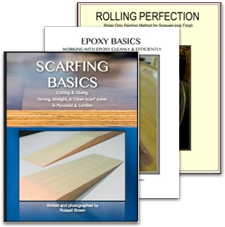Badtux nails it, about that "Big Lie" and in the "Why am I not surprised" department...
I often read in the boating press about the advantages and general wonderfulness of carbon fiber and I suspect you do too. The thing is do you ever read about how using carbon fiber can actually save you money?
I thought not.
A little back story, the first time I ever came across the words carbon + fiber used together was in the early 70's when my dad came home with a new obscenely expensive golf club. The next time was when (mid-70's) I was designing backpacks and tents for a company and the nice rep from Easton have me a huge box of carbon fiber rods, profiles, and tubes to play with in the hopes I would use them in upcoming designs (I did). Later on, when I mentioned I was building a bike frame, he gave me two carbon frame tube sets which I proceeded to turn into touring bikes.
At about the same time, a friend who was a guitar tech told me that a good way to keep my 12-string guitar necks from warping was to add a couple of small carbon rods under the fret board. They worked finest kind!
My eyes were opened to the myriad possibilities of carbon and as a result I've used it on surfboards, guitars, automobiles, and, yes dear reader, boats.
So, you might say, I have a certain amount of hands on/practical experience with the use of carbon and I like it. Fact is, the thing I like about it most is how it saves money when used with a little thought.
I mention this partly because just the other day someone emailed me and asked how my mast beam on "So It Goes" has held up over the years. For those unacquainted with CALs and their mast beam issues the problem is the mast beams are steel and most all need to be replaced at some time or other because they rust out. When I replaced mine I built a new beam in laminated plywood with carbon reinforcement instead of going the accepted route of having one built in stainless steel. A whole bunch of years later the beam is still rigid, rot free and non-problematically doing its job.
Admittedly the reason I chose to do the beam in ply/carbon/epoxy was more to do with the staggeringly expensive quote I got for a guy to weld up a stainless steel one and the fact that I happened to have some scrap marine ply of just about the right size, a roll of 6" carbon fiber unidirectional tape, and plenty of epoxy on hand so a new beam meant no out-of-pocket expense.
For those with a need to know It would have cost me maybe $100 total at today's prices to build the beam in ply/carbon/epoxy while I'd expect a stainless one would cost at least $600 or so at the very minimum.
A little carbon in matrix with wood is a wonderful thing.
Of course, today there is a lot of bad science used around the word "carbon" and the engineering of marine gear seems to have morphed into and all-or-nothing approach which seems to be good for the people who sell carbon fiber and related services but not so good for folks who have to pay for it.
Take the 12-string guitar necks as an example... Guitar necks have, in general, a lot of stress due to the forces of the strings. A 12-string has lots more which tend to cause "issues". Most 12-string necks are strong enough in general but a little extra climatic stress or not keeping the guitar in tune mixed with maybe a little less than perfect grain structure in the wood chosen for the neck may add just that extra bit of force which may result in a warping of the neck. Adding a bit of carbon to the mix gives the neck that little bit of extra strength to make the neck bombproof. A simple, cheap, and easily added to the guitar building process without hassle fix.
Now, the current marine engineering solution would be to make the 12-string neck completely out of carbon fiber with the most high tech carbon and epoxy vacuum infused and baked in an autoclave. The resulting neck with be like 100 times stronger than the wood neck but at such a high cost that you cannot afford to buy it. On the other hand, the wood/carbon composite neck is more than strong enough and only add a few dollars to the cost of the neck. Less often makes more sense.
The important thing to keep in mind is that, in a composite structure done right, each element of the structure needs to pull its own weight and in wood/carbon composite all the carbon need to do is to "help" the wood and not replace it.
Used correctly carbon added to the mix saves money used incorrectly you're just being scammed.
Listening to Grateful Shred
So it goes...
Live Aboard MacroEconomics: A Case Study
3 days ago








